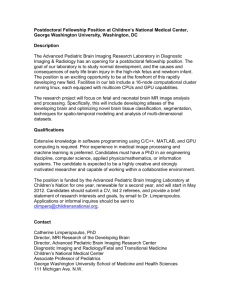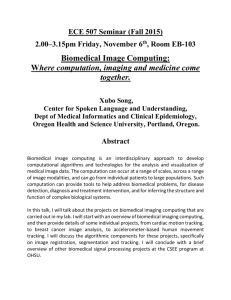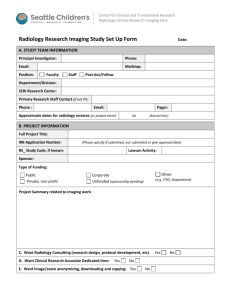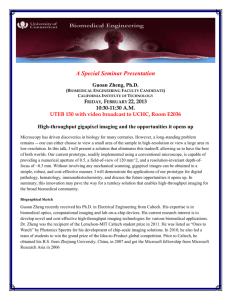Lecture Slides
advertisement
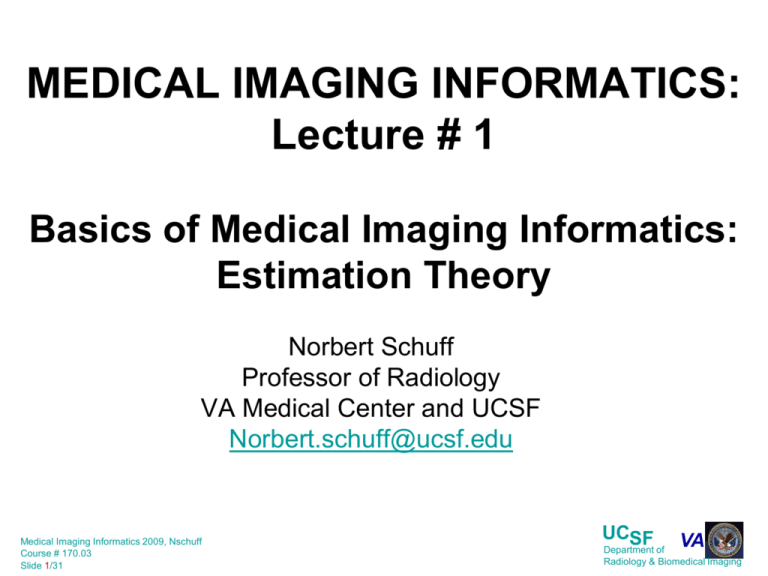
MEDICAL IMAGING INFORMATICS: Lecture # 1 Basics of Medical Imaging Informatics: Estimation Theory Norbert Schuff Professor of Radiology VA Medical Center and UCSF Norbert.schuff@ucsf.edu Medical Imaging Informatics 2009, Nschuff Course # 170.03 Slide 1/31 UCSF VA Department of Radiology & Biomedical Imaging What Is Medical Imaging Informatics? • • • • • • • • • • • • • • • • • • • • • Picture Archiving and Communication System (PACS) Imaging Informatics for the Enterprise Image-Enabled Electronic Medical Records Radiology Information Systems (RIS) and Hospital Information Systems (HIS) Digital Image Acquisition Image Processing and Enhancement Image Data Compression 3D, Visualization and Multi-media Speech Recognition Computer-Aided Detection and Diagnosis (CAD). Imaging Facilities Design Imaging Vocabularies and Ontologies Data-mining from medical image databases Transforming the Radiological Interpretation Process (TRIP)[2] DICOM, HL7 and other Standards Workflow and Process Modeling and Simulation Quality Assurance Archive Integrity and Security Teleradiology Radiology Informatics Education Etc. Medical Imaging Informatics 2009, Nschuff Course # 170.03 Slide 2/31 UCSF VA Department of Radiology & Biomedical Imaging What Is Our Focus? Learn using computation tools to maximize information and gain knowledge Pro-active Improve Data collection Measurements Imaging Extract information Re-active Medical Imaging Informatics 2009, Nschuff Course # 170.03 Slide 3/31 Refine Model knowledge Model Compare with model UCSF VA Department of Radiology & Biomedical Imaging Challenge: Extract Maximum Information 1. Q: How can we estimate quantities of interest from a given set of uncertain (noise) measurements? A: Apply estimation theory (1st lecture by Norbert) 2. Q: How can we code the quantities? A: Apply information theory (2nd lecture by Wang) Medical Imaging Informatics 2009, Nschuff Course # 170.03 Slide 4/31 UCSF VA Department of Radiology & Biomedical Imaging Estimation Theory: Motivation Example I Gray/White Matter Segmentation Hypothetical Histogram 1.0 0.8 0.6 0.4 0.2 0.0 Intensity GM/WM overlap 50:50; Can we do better than flipping a coin? Medical Imaging Informatics 2009, Nschuff Course # 170.03 Slide 5/31 UCSF VA Department of Radiology & Biomedical Imaging Estimation Theory: Motivation Example II Goal: Capture dynamic signal on a static background Courtesy of Dr. D. Feinberg Advanced MRI Technologies, Sebastopol, CA Medical Imaging Informatics 2009, Nschuff Course # 170.03 Slide 6/31 UCSF VA Department of Radiology & Biomedical Imaging Basic Concepts Suppose we have N scalar measurements : xN x 1 , x 2 ,...x N We want to determine M quantities (parameters): Definition: An estimator is: Error estimator: Medical Imaging Informatics 2009, Nschuff Course # 170.03 Slide 7/31 T θM 1 , 2 ,... M T θ̂ j h j x N ; j M θ θˆ θ; for N >M UCSF VA Department of Radiology & Biomedical Imaging Examples of Estimators N 1 Mean Value: ˆ x j N j 1 150 Intensities (Y) 100 50 Variance 0 ˆ ˆ 2 N 1 x j ˆ N 1 j 1 -50 100 300 500 700 900 Measurements (x) Amplitude: 200 Frequency: Intensity 100 Phase: 0 Decay: -100 100 300 500 700 Measurements Medical Imaging Informatics 2009, Nschuff Course # 170.03 Slide 8/31 ˆ1 ˆ2 ˆ3 ˆ4 900 UCSF VA Department of Radiology & Biomedical Imaging 2 Some Desirable Properties of Estimators I: Unbiased: Mean value of the error should be zero E θˆ - θ = E θ 0 E θˆ E θ Consistent: Error estimator should decrease asymptotically as number of measurements increase. (Mean Square Error (MSE)) MSE E θ̂ - θ 2 0 for large N If estimator is biased MSE E θ̂ - θ - b variance Medical Imaging Informatics 2009, Nschuff Course # 170.03 Slide 9/31 2 E b 2 bias UCSF VA Department of Radiology & Biomedical Imaging Some Desirable Properties of Estimators II: Efficient: Co-variance matrix of error should decrease asymptotically to its minimal value, i.e. inverse of Fisher’s information matrix) for large N ˆ ˆ Cθ E θ-θ θ-θ Medical Imaging Informatics 2009, Nschuff Course # 170.03 Slide 10/31 T 1 J max UCSF VA Department of Radiology & Biomedical Imaging Example: Properties Of Estimators Mean and Variance Mean: 1 N 1 ˆ E E x j N N j 1 N The sample mean is an unbiased estimator of the true mean Variance: E ˆ 2 1 N 2 E N j 1 x j 2 1 2 2 2 N N N The variance is a consistent estimator because It approaches zero for large number of measurements. Medical Imaging Informatics 2009, Nschuff Course # 170.03 Slide 11/31 UCSF VA Department of Radiology & Biomedical Imaging Least-Squares Estimation Linear Model: xN HθM v N vN 0 Generally: x1 h111 h12 2 v1 100 Y2 where N > M x2 h211 h22 2 v2 80 ... .... 60 xN hN 11 hN 2 2 vN 40 0 50 100 150 200 250 Y1 Medical Imaging Informatics 2009, Nschuff Course # 170.03 Slide 12/31 UCSF VA Department of Radiology & Biomedical Imaging Least-Squares Estimation The best what we can do: ELSE arg min 1 vN 2 2 1 T x H x H N M N M 2 Minimizing ELSE with regard to leads to H T x N H T H θˆ LSE 0 θLSE HT H H T xn 1 •LSE is popular choice for model fitting •Useful for obtaining a descriptive measure But •Makes no assumptions about distributions of data or parameters •Has no basis for statistics Medical Imaging Informatics 2009, Nschuff Course # 170.03 Slide 13/31 UCSF VA Department of Radiology & Biomedical Imaging Maximum Likelihood (ML) Estimator We have: x N x 1 , x 2 ,...x T T Xn is random sample from a pool with certain probability distribution. Goal: Find that gives the most likely probability distribution underlying xN. ˆ ML arg max p xN | θ Max likelihood function ML can be found by dy ln p x N | θ 0 dθ θ θ ML Medical Imaging Informatics 2009, Nschuff Course # 170.03 Slide 14/31 UCSF VA Department of Radiology & Biomedical Imaging Example I: ML of Normal Distribution ML function of a normal distribution p xN | , log ML function 1st log ML equation MLE of the mean 2nd log ML equation MLE of the variance Medical Imaging Informatics 2009, Nschuff Course # 170.03 Slide 15/31 2 2 2 N /2 1 N 2 exp 2 x j 2 j 1 2 N 1 N 2 ln p xN | , ln 2 2 x j 2 2 j 1 2 d 1 2 ln p xN | ˆ ML , ˆ ML ˆ 2 d ML ˆ ML N x j ˆ 0 j 1 1 N x j N j 1 d N 1 2 ˆ ˆ ln p x | , N ML ML 2 4 dˆ 2 2ˆ ML 4ˆ ML ˆ 2 ML ML N x j ˆ 0 j 1 ML 1 N x j ˆ ML N j 1 UCSF VA Department of Radiology & Biomedical Imaging Example II: Binominal Distribution (Coin Toss) Probability density function: n= number of tosses w= probability of success f y | n, w n! n y w y 1 w y ! n y ! 0.7 0.2 y 0.1 f(y|n=10,w) 0.0 0.3 0.2 0.1 0.0 1 Medical Imaging Informatics 2009, Nschuff Course # 170.03 Slide 16/31 2 3 4 5 N y 6 7 8 9 10 UCSF VA Department of Radiology & Biomedical Imaging Likelihood Function Of Coin Tosses Given the observed data f (y|w=0.7, n=10) (and model), find the parameter w that most likely produced the data. L(w | y 7, n 10) f y | w 0.7, n 10 Likelihood 0.25 0.20 0.15 0.10 0.05 0.00 0.1 Medical Imaging Informatics 2009, Nschuff Course # 170.03 Slide 17/31 0.3 0.5 W 0.7 0.9 UCSF VA Department of Radiology & Biomedical Imaging ML Estimation Of Coin Toss Compute log likelihood function n! ln L w | y ln y ln w n y ln 1 w y ! n y ! Evaluate ML equation d ln L w | y y n y 0 dw w 1 w y nw y 0 wMLE w(1 w) n According to the MLE principle, the PDF f(y|w=y/n) for a given n is the distribution that is most likely to have generated the observed data of y. Medical Imaging Informatics 2009, Nschuff Course # 170.03 Slide 18/31 UCSF VA Department of Radiology & Biomedical Imaging Connection between ML and LSE Assume: are independent of vN ML and vN have the same distribution pθ xN | θ pv xN Hθ | θ vN is zero mean and gaussian ML function of a normal distribution 2 T 1 1 p x N | θ exp 2 x N Hθ x N Hθ exp 2 x N Hθ 2 2 Clearly, p(x|) is maximized when LSE is minimized Medical Imaging Informatics 2009, Nschuff Course # 170.03 Slide 19/31 UCSF VA Department of Radiology & Biomedical Imaging Properties Of The ML Estimator • is consistent: the MLE recovers asymptotically the true parameter values that generated the data for N inf; • Is efficient: The MLE achieves asymptotically the minimum error (= max. information) Medical Imaging Informatics 2009, Nschuff Course # 170.03 Slide 20/31 UCSF VA Department of Radiology & Biomedical Imaging Maximum A-Posteriori (MAP) Estimator We have random sample: x N x 1 , x 2 ,...x T We also have random parameters: T θ p θ Goal: Find the most likely (max. posterior density of ) given xN. ˆ MAP arg max p xN | θ p θ Maximize joint density MAO can be found by dy ln p x N | θ p θ ln p x N | θ ln p θ 0 dθ θ θ θ θ MAP Medical Imaging Informatics 2009, Nschuff Course # 170.03 Slide 21/31 UCSF VA Department of Radiology & Biomedical Imaging MAP Of Normal Distribution We have random sample: 1 N 1 N 2 2 ln p xN | ˆ , ˆ p ˆ , ˆ 2 x j ˆ x 2 p ˆ ML 0 uˆ ˆ x j 1 ˆ μ j 1 The sample mean of MAP is: μˆ MAP 2 N T 2 x 2 x j j 1 If we do not have prior information on , inf or T inf μˆ MAP μˆ ML , μˆ LSE Medical Imaging Informatics 2009, Nschuff Course # 170.03 Slide 22/31 UCSF VA Department of Radiology & Biomedical Imaging Posterior Density and Estimators p(|x) MSE X Medical Imaging Informatics 2009, Nschuff Course # 170.03 Slide 23/31 MAP UCSF VA Department of Radiology & Biomedical Imaging Summary • LSE is a descriptive method to accurately fit data to a model. • MLE is a method to seek the probability distribution that makes the observed data most likely. • MAP is a method to seek the most probably parameter value given prior information about the parameters and the observed data. • If the influence of prior information decreases, i.e. many any measurements, MAP approaches MLE Medical Imaging Informatics 2009, Nschuff Course # 170.03 Slide 24/31 UCSF VA Department of Radiology & Biomedical Imaging Some Priors in Imaging • • • • • Smoothness of the brain Anatomical boundaries Intensity distributions Anatomical shapes Physical models – Point spread function – Bandwidth limits • Etc. Medical Imaging Informatics 2009, Nschuff Course # 170.03 Slide 25/31 UCSF VA Department of Radiology & Biomedical Imaging Imaging Software Using MLE And MAP Medical Imaging Informatics 2009, Nschuff Course # 170.03 Slide 26/31 UCSF VA Department of Radiology & Biomedical Imaging Segmentation Using MLE A: Raw MRI B: SPM2 C: EMS D: HBSA from Habib Zaidi, et al, NeuroImage 32 (2006) 1591 – 1607 Medical Imaging Informatics 2009, Nschuff Course # 170.03 Slide 27/31 UCSF VA Department of Radiology & Biomedical Imaging Brain Parcellation Using MLE Manual EM-Affine EM-NonRigid EM-Simultaneous Kilian Maria Pohl, Disseration 1999 Prior information for Brain parcellation Medical Imaging Informatics 2009, Nschuff Course # 170.03 Slide 28/31 UCSF VA Department of Radiology & Biomedical Imaging MAP Estimation In Image Reconstruction Human brain MRI. (a) The original LR data. (b) Zero-padding interpolation. (c) SR with box-PSF. (d) SR with Gaussian-PSF. From: A. Greenspan in The Computer Journal Advance Access published February 19, 2008 Medical Imaging Informatics 2009, Nschuff Course # 170.03 Slide 29/31 UCSF VA Department of Radiology & Biomedical Imaging Literature Mathematical • H. Sorenson. Parameter Estimation – Principles and Problems. Marcel Dekker (pub)1980. Signal Processing • S. Kay. Fundamentals of Signal Processing – Estimation Theory. Prentice Hall 1993. • L. Scharf. Statistical Signal Processing: Detection, Estimation, and Time Series Analysis. Addison-Wesley 1991. Statistics: • A. Hyvarinen. Independent Component Analysis. John Wileys & Sons. 2001. • New Directions in Statistical Signal Processing. From Systems to Brain. Ed. S. Haykin. MIT Press 2007. Medical Imaging Informatics 2009, Nschuff Course # 170.03 Slide 30/31 UCSF VA Department of Radiology & Biomedical Imaging

